![]()
![]()
![]()
Use LEFT and RIGHT arrow keys to navigate between flashcards;
Use UP and DOWN arrow keys to flip the card;
H to show hint;
A reads text to speech;
8 Cards in this Set
- Front
- Back
|
What is the significance of 23.5 degrees? |
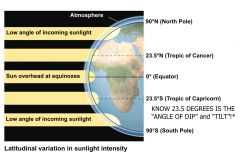
Latitudinal Variation in Sunlight IntensityAffects the sunlight's intensity? The angle at which sunlight hits Earth affects its intensity, the amount of heat and light per unit of surface areaWhere is sunlight intensity strongest? The intensity of sunlight is strongest in the tropics (between 23.5° north latitude and 23.5° south latitude) where sunlight strikes Earth most directly |
|
|
What are the 10 terrestrial biomes? |

Tropical ForestDistribution is in equatorial and subequatorial regionsIn tropical rain forests, rainfall is relatively constant, while in tropical dry forests precipitation is highly seasonalTemperature is high year-round (25–29°C) with little seasonal variation DesertDeserts occur in bands near 30° north and south of the equator, and in the interior of continentsPrecipitation is low and highly variable, generally less than 30 cm per yearTemperature is variable seasonally and dailyDeserts may be hot or cold |
|
|
What is permafrost? |

|
|
|
What is an ecotone? |
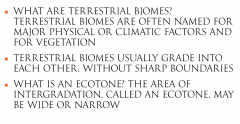
|
|
|
Draw zonation in a lake. |
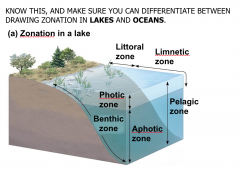
|
|
|
Draw marine zonation. |

|
|
|
What are oligotrophic/eutrophic lakes? |
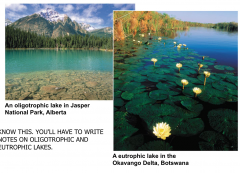
Oligotrophic lakes are nutrient-poor and generally oxygen-richWhat are eutrophic lakes? Eutrophic lakes are nutrient-rich and often depleted of oxygen in deep zones or throughout if ice covered in winter Oligotrophic lakes have less surface area relative to depth than eutrophic lakes |
|
|
What are coral reefs? |
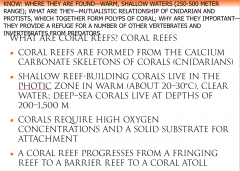
coral reef in Red Sea What animals and plants are found in cora reefs? Corals form a mutualistic relationship with unicellular algae, which provide them with organic moleculesIn addition to corals, other invertebrates and fish are also exceptionally diverseCollection of coral skeletons, overfishing, global warming, pollution, and aquaculture are threats to coral reef ecosystems |

